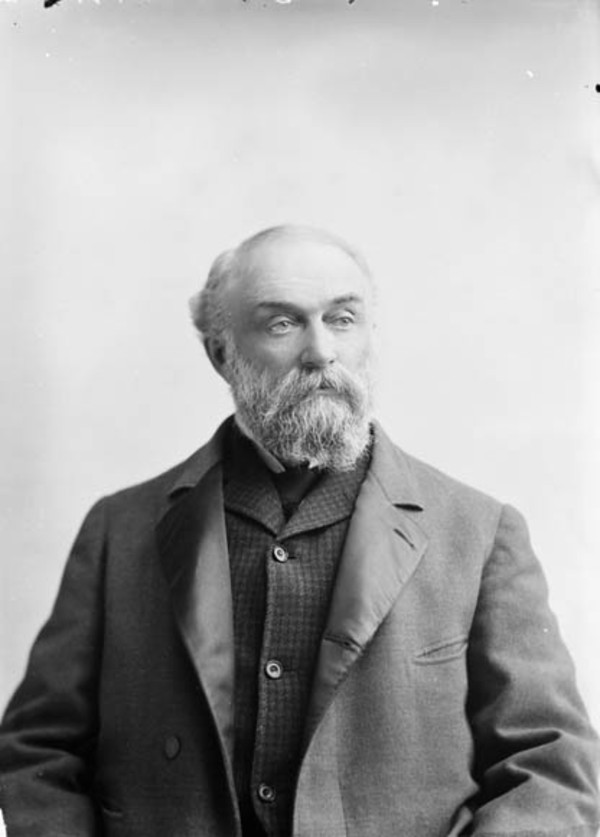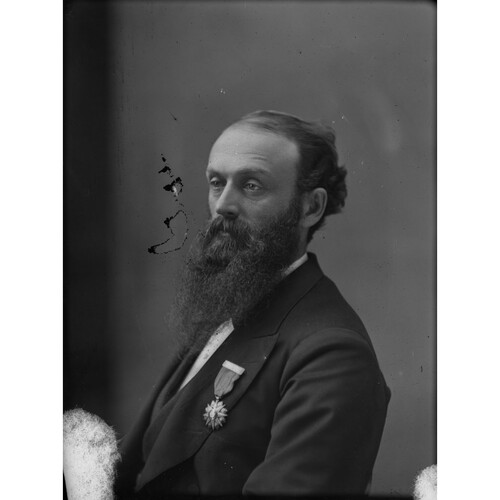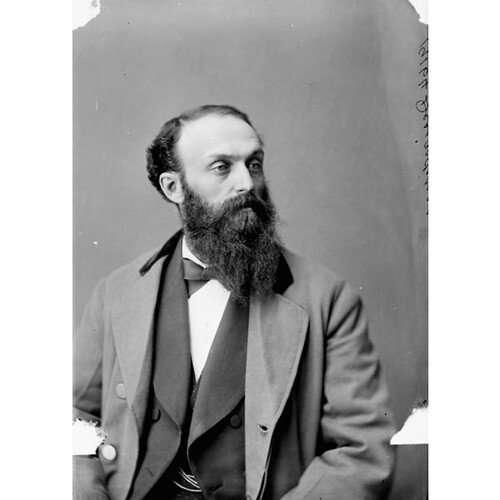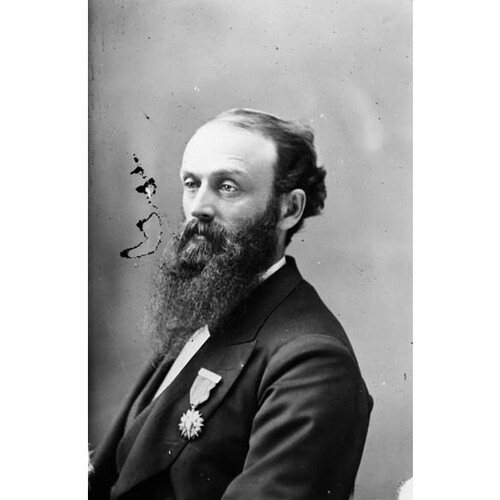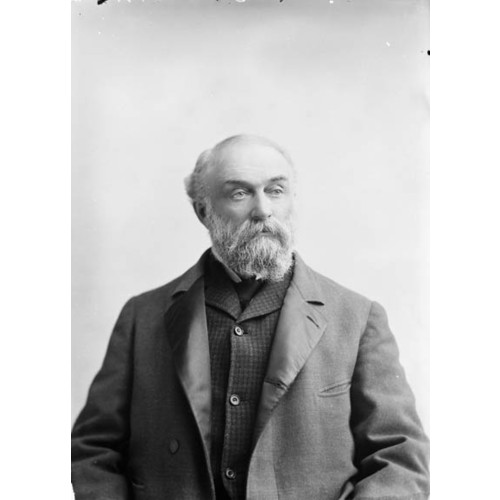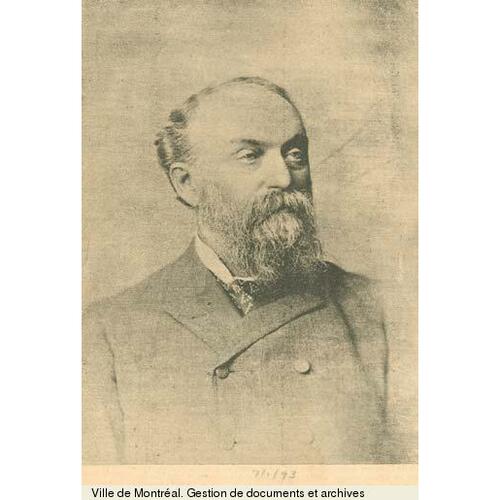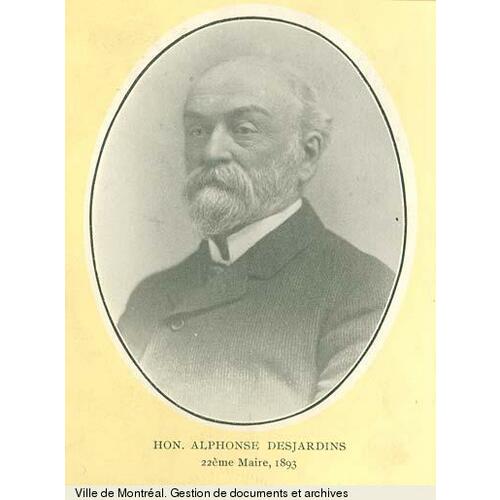DESJARDINS, ALPHONSE (baptized Charles-Alphonse), lawyer, journalist, politician, and businessman; b. 6 May 1841 in Terrebonne, Lower Canada, son of Édouard Desjardins, a bailiff, and Joséphine Panneton; m. first 19 May 1864, in Montreal, Justine-Virginie Paré (1839–79), daughter of merchant Hubert Paré* and Justine Vinet, and they had seven children, of whom three died young; m. there secondly 24 May 1880 Hortense Barsalou (1857–1930), daughter of auctioneer and industrialist Joseph Barsalou* and Adele Gravel, and they had 16 children, of whom seven died in infancy; d. 4 June 1912 in Terrebonne.
Alphonse Desjardins came from a family that had been established in New France since the 17th century and in Terrebonne since 1729; he thus had deep roots in the place where he was raised and where, after a career in Montreal, he died. The family of businessman Joseph Masson*, the seigneur of Terrebonne, was highly influential in the region and the Masson and Desjardins families were linked in numerous ways. One of Alphonse’s sisters and two of his daughters married into the Massons, he himself was an executor of Joseph’s estate, and he worked closely with Louis-Rodrigue Masson* in the Conservative party.
Desjardins did classical studies at the Collège Masson in Terrebonne, where he was friends with Joseph-Adolphe Chapleau* and Louis-Olivier Taillon*. He completed the program in 1857–58 at the Séminaire de Nicolet. One of his professors there was Louis-François Laflèche*, the future bishop of Trois-Rivières, who probably helped shape his ultramontane ideas. In 1858 he enrolled in the law school at the Collège Sainte-Marie in Montreal, and he was called to the bar in 1862. He practised law for six years, dabbling in journalism at the same time, and then decided to pursue a career in the latter profession. In 1868 he was employed as an editor and parliamentary correspondent for L’Ordre (Montréal), which he left in 1871. He joined Le Nouveau Monde (Montréal) in 1872, becoming a shareholder and vice-chairman of the editorial board; the following year he succeeded Cléophas Beausoleil* as editor-in-chief.
Desjardins was then part of a group of young ultramontane laity that Bishop Ignace Bourget* had gathered around him to defend the church against a perceived liberal threat. He had supported the Zouave movement, which sent a contingent to defend the papal territories in 1868. In 1871 he organized at his home the famous meeting that led to the drafting of the Programme catholique [see François-Xavier-Anselme Trudel*]. Although the Programmistes strongly backed the Conservative party, they argued that politicians should bring their actions into line with church directives. Desjardins’s decision to turn to journalism and especially the fact that he went to Le Nouveau Monde reflected his desire to spread ultramontane ideas. This daily newspaper had been founded in 1867 on the initiative of Bourget, who wanted the church to have a voice in the press at a time when the struggle against liberalism was reaching its zenith. The paper’s constitution required a majority of the shareholders and directors to be clergy and a religious censor to supervise the journalists and ensure that their writing conformed with “Catholic principles.” The arrival of Desjardins coincided with changes in the writing staff, which came to include several authors of the Programme catholique; this infusion of new energy was termed “the spirit of 1872.” Proclaiming the primacy of the spiritual over the temporal, Le Nouveau Monde engaged in numerous polemics; it promoted Programmiste and ultramontane ideas in a dogmatic tone, denouncing compromise and attacking liberalism and liberals. In 1874 a new career in politics and business prompted Desjardins to resign as editor-in-chief. He none the less remained connected to the paper as an important shareholder and éminence grise until 1879, when it was sold to Frédéric Houde*. Thus ended the most militant phase of Desjardins’s ultramontanist activity. He remained faithful, however, to the ideals of his youth: in 1893, as mayor of Montreal, he refused to preside at the official welcome of sailors from a visiting Italian frigate since they represented a government “hostile to the Holy Father.” He had been made a knight of the Order of Pius IX in 1872 in recognition of his services to the church.
With the federal election of 1874, Desjardins decided to enter politics. An independent Conservative candidate in Hochelaga, a Montreal suburb, he was returned by acclamation. Successful in the next four elections, he sat for 18 years in the House of Commons. One of the first issues to attract his attention was the New Brunswick school question. He warmly supported John Costigan’s unsuccessful motion in 1875 to re-establish the rights of Catholic separate schools, which had been suppressed by the provincial legislature in 1871.
Desjardins was also an important player in the debates concerning Louis Riel*. He had known the Métis leader through Mme Masson (Marie-Geneviève-Sophie Raymond), of whom Riel was a protégé. When amnesty for participants in the events at Red River (Man.) was being considered, he vigorously opposed the five-year exile imposed on Riel and his right-hand man Ambroise-Dydime Lépine* in 1875. Historian Robert Rumilly* claims Desjardins had even secretly sheltered the fugitive Riel in his Montreal home. In May 1874 Riel wrote from St Paul, Minn., to thank him, as well as his wife, his father, and his brother Louis-Édouard, “for the special attention which has been lavished on me.” In 1885, after Riel had been condemned to death, Desjardins organized the lobbying of numerous Quebec mps, who urged Prime Minister Sir John A. Macdonald* not to carry out the sentence. Like several other ultramontanes, he broke publicly with his party after the hanging of Riel, even choosing to sit with the opposition. He helped arrange demonstrations in Quebec and spoke out, most notably at the famous Champ-de-Mars protest in Montreal on 22 Nov. 1885.
The alliance of Quebec’s National Conservatives with the Liberals, whom he had fought so bitterly in Le Nouveau Monde and other forums, made Desjardins uneasy, however. During the federal election of 1887 the Liberal policy of reciprocity gave him a pretext to return to the Conservative fold, where he had always been an ardent protectionist. Faithful to the principles of the Programme catholique, he was strongly attached to his party, becoming one of its leaders in the Montreal region. Although identified with the ultramontane wing, he was very close to Chapleau, his boyhood friend, with whom he was associated in various business ventures. This situation illustrates the complexity of relationships among Quebec Conservatives. United when certain religious and nationalist principles were at stake, the ultramontanes did not form, as is often suggested, a homogeneous and isolated bloc. They frequently worked with other members of the party and sometimes were divided among themselves on issues unrelated to doctrine.
In the House of Commons Desjardins, drawing on his experience as a journalist and parliamentary correspondent, for several years chaired the debates committee, which supervised the publication and translation of mps’ speeches. His connections with the business world also led him to speak often on economic issues and to participate in the work of the standing committee on banking and commerce.
In 1892 Desjardins was appointed to the Senate as a replacement for Sir Alexandre Lacoste*. He was soon drawn from this semi-retirement by the Manitoba school question which, like the crisis in New Brunswick 20 years earlier, raised what he saw as a fundamental issue: the educational rights of Catholic minorities. Since Prime Minister Sir Mackenzie Bowell had promised to introduce remedial legislation, Desjardins agreed to join the cabinet. On 15 Jan. 1896 he was named minister of militia and defence, an office he held until Bowell’s resignation on 27 April. On 1 May he was given the Department of Public Works in Sir Charles Tupper’s cabinet. With Sir Donald Alexander Smith and Arthur Rupert Dickey, he had been part of the federal delegation sent to Winnipeg in March for a final attempt at negotiations with the Manitoba government. The failure of their mission left the Conservatives no other option than remedial legislation, but the Liberals’ obstruction made its passage impossible before the end of the government’s term, and the prime minister was forced to call an election in June. At that point Desjardins agreed to resign his Senate seat in order to throw himself into the contest by running in Richelieu. A Liberal wave swept the province, however, and his political career ended in bitter defeat. He continued to play a role in the Conservative party in the Montreal region, but he never stood for election again.
Desjardins had made a brief incursion into municipal politics. In 1893, with the support in particular of anglophone reformers [see George Washington Stephens*], he ran for the mayoralty of Montreal. His opponent, the populist incumbent James McShane, did not take defeat gracefully, backing an unsuccessful attempt to get the election annulled. In his speeches as mayor, Desjardins stressed, from a reform perspective, the need for better control of municipal finances; he also vigorously promoted annexation of suburban municipalities and development of the port. However prestigious, the mayoralty brought little power beyond that of persuasion. This reality may explain why Desjardins held office for only one year and did not seek a second term in 1894. Later he served on the executive of the Citizens’ Association of Montreal, an organization established by reformers.
Desjardins had a career in business as well as in politics. The source of his wealth is unknown, but his two marriages to daughters of important French Canadian businessmen probably eased his entry into the field. Furthermore, for many years he was the administrator of the large estate left by his first wife to their children. Desjardins made his mark especially as president of the Banque Jacques-Cartier, which had been founded in 1861 by francophone merchants including his father-in-law Hubert Paré. In 1875 the bank experienced serious difficulties following accounting irregularities by the cashier (general manager) as well as some risky loans. Forced to close for nearly three months [see Vite-Adélard Le Moyne* de Martigny], it took several years to become profitable again. After joining the board of directors in 1876, Desjardins participated in the reorganization of the bank; it was firmly re-established by 1879 when he became president, and he retained the office for 20 years. Under his leadership the bank entered a period of growth which continued until the end of the 19th century. It held the savings of French Canadian clients and lent to francophone businessmen.
At various points in his career, Desjardins was associated with many other enterprises, notably in the financial sector. He was vice-president of the Sovereign Fire Insurance Company, the Canada Accident Assurance Company, the Guardian Assurance Company Limited, and the Canada Agricultural Assurance Company, and a director of the National Insurance Company. He was involved in transportation as a director and then vice-president of the Richelieu and Ontario Navigation Company and as vice-president of the Montreal and Western Railway Company. In 1882, with Thomas McGreevy* and Joseph-Aldric Ouimet, he headed a financial syndicate backed by Louis-Adélard Senécal* which acquired the eastern section of the Quebec, Montreal, Ottawa and Occidental Railway, put on the market by the Chapleau government. He was one of the first to invest in the asbestos mines of the Eastern Townships, where he owned shares in the Coleraine Mining Company. He was also a shareholder in the Imperial Brush Manufacturing Company.
In addition, Desjardins made his mark as a real estate promoter and helped create the town of Maisonneuve, where he lived for several years. He had begun investing there in 1874, when the area was still part of the municipality of Hochelaga. That year, with other associates including Senator François-Xavier-Anselme Trudel, he acquired a huge piece of property – the Domaine Mathieu – for urban development. He gradually increased his share of it so that by 1890 he and other members of his family would be the sole owners. The land was divided and over time the lots were sold, either to manufacturing concerns or for residential construction; after his death the municipality would buy much of the remainder in order to create the vast Parc Maisonneuve. Like his father-in-law Joseph Barsalou, Desjardins belonged to a group of promoters who sought to get the land they owned in eastern Hochelaga made a separate municipality. This goal was achieved in 1883 after most of Hochelaga was annexed to Montreal [see Raymond Préfontaine*]. The town of Maisonneuve was created from the remainder, and Barsalou became its first mayor; Desjardins’s son Hubert was the mayor from 1894 to 1896 and 1897 to 1901, and a councillor from 1902 to 1904. With the support of its main real estate promoters, Maisonneuve became one of the most dynamic municipalities of suburban Montreal and a major industrial town before it was annexed in 1918. The name of a street that goes through the original Domaine Mathieu has since that era honoured the important role of Desjardins. He also acquired about ten rental properties in various parts of Montreal.
Desjardins invested in the manufacturing sector as well, setting up the Montreal Terra Cotta Lumber Company in 1887 to make fire-brick. He was the company’s president and Hubert its manager. The enterprise was located on his own property in Maisonneuve, and the raw clay was extracted there.
An influential and respected businessman in Montreal during the last quarter of the 19th century, Desjardins was admired by his francophone colleagues. In 1898 and 1899 they elected him president of the Chambre de Commerce du District de Montréal, of which he had been a founder. He made himself their spokesman by championing the development of the port in the city’s east end. After his presidency he continued to play an active role in the discussions of the chamber and its committees.
In 1899 Desjardins experienced a significant reversal of his fortunes. The failure of the Banque Ville-Marie [see William Weir*] created a panic among depositors, who fled Montreal’s francophone banks. The Banque Jacques-Cartier felt the repercussions. Although well managed and profitable, it was unable to meet the volume of withdrawals and had to close for several weeks; it was then reorganized and the following year became the Banque Provinciale du Canada. To weather the storm, however, Desjardins had given personal guaranties and he found himself heavily in debt to the bank. Faced with the hostility of the other directors, he had to resign the presidency and give his properties as securities. The affair took an acrimonious turn and required some years to settle.
Desjardins also had intellectual interests. He was secretary of the Institut Canadien-Français and president of Montreal’s Cercle Littéraire. He often invited the members of the Société Canadienne d’Économie Sociale de Montréal to his home and he served as its treasurer from 1888 to 1897 and president from 1897 to 1899 and 1907 to 1911. Moreover, he became a governor of the Montreal branch of the Université Laval.
The intense and varied career of Alphonse Desjardins is particularly significant. He was part of the generation of young ultramontanes who from the time of confederation and for more than a quarter of a century were to influence profoundly the political life of Quebec and Canada, and whose universe crumbled in 1896–97 when the Liberals came to power in Ottawa and then in Quebec. He was part also of the new wave of francophone entrepreneurs emerging in Montreal during the second half of the 19th century. He can be credited with the success of a francophone bank which, despite the difficulties of 1899, continued to develop in the next century and was one of the important financial institutions available to French Canadians. His career demonstrates further the well-documented links between politics and business in the 19th century and shows that this linkage was as common among ultramontanes as among other politicians. His life illustrates as well the widespread phenomenon of the lawyer who seldom practises his profession but uses it as a springboard to other careers.
[The author would like to thank Professor Ronald Rudin for supplying details concerning Alphonse Desjardins’s connections with the Banque Jacques-Cartier. p.-a.l.]
ANQ-M, CE1-1, 19 mai 1864, 24 mai 1880; CE6-24, 7 mai 1841. Arch. de la Compagnie de Jésus, Prov. du Canada Français (Saint-Jérôme, Qué.), Fonds Alphonse Desjardins; Fonds Paul Desjardins. Centre de Recherche Lionel-Groulx (Outremont, Qué.), P-19 (fonds Alphonse-Desjardins, sénateur). Le Devoir, 5 juin 1912. Gérard Bouchard, “Apogée et déclin de l’idéologie ultramontaine à travers le journal le Nouveau-Monde (1867–1900): étude sociologique de la connaissance” (thèse de ma, univ. Laval, Québec, 1968). Canadian men and women of the time (Morgan; 1898 and 1912). CPG, 1874–96. J.-J. A. [Joseph Desjardins], Le sénateur Alphonse Desjardins, journaliste et homme public, 1841–1912 (Montréal, 1944). J.-C. Lamothe, Histoire de la corporation de la cité de Montréal depuis son origine jusqu’à nos jours . . . (Montréal, 1903), 315–17. P.-A. Linteau, Maisonneuve ou comment des promoteurs fabriquent une ville, 1883–1918 (Montréal, 1981). Gérard Masson, Alphonse Desjardins, journaliste et homme politique, 1841–1912; étude généalogique ([Outremont], 1982). Fernande Roy, Progrès, harmonie, liberté: le libéralisme des milieux d’affaires francophones de Montréal au tournant du siècle (Montréal, 1988). Ronald Rudin, Banking en français: les banques canadiennes-françaises de 1835 à 1925 (Montréal, 1988), 58–60, 95–104. Rumilly, Hist. de Montréal, vol.3. [Télesphore Saint-Pierre], Histoire du commerce canadien-français de Montréal, 1535–1893 (Montréal, 1894), 111. Léon Trépanier, “Figures de maires,” Cahiers des Dix, 23 (1958): 260–83. Pierre Trépanier, “La Société canadienne d’économie sociale de Montréal, 1888–1911: sa fondation, ses buts et ses activités,” CHR, 67 (1986): 343–67; “La Société canadienne d’économie sociale de Montréal (1888–1911): ses membres, ses critiques et sa survie,” Social Hist. (Ottawa), 19 (1986): 299–322. Les ultramontains canadiens-français, sous la direction de Nive Voisine et Jean Hamelin (Montréal, 1985). B. J. Young, Promoters and politicians: the north-shore railways in the history of Quebec, 1854–85 (Toronto, 1978).
Cite This Article
Paul-André Linteau, “DESJARDINS, ALPHONSE (baptized Charles-Alphonse) (1841-1912),” in Dictionary of Canadian Biography, vol. 14, University of Toronto/Université Laval, 2003–, accessed January 1, 2026, https://www.biographi.ca/en/bio/desjardins_alphonse_1841_1912_14E.html.
The citation above shows the format for footnotes and endnotes according to the Chicago manual of style (16th edition). Information to be used in other citation formats:
| Permalink: | https://www.biographi.ca/en/bio/desjardins_alphonse_1841_1912_14E.html |
| Author of Article: | Paul-André Linteau |
| Title of Article: | DESJARDINS, ALPHONSE (baptized Charles-Alphonse) (1841-1912) |
| Publication Name: | Dictionary of Canadian Biography, vol. 14 |
| Publisher: | University of Toronto/Université Laval |
| Year of publication: | 1998 |
| Year of revision: | 1998 |
| Access Date: | January 1, 2026 |


